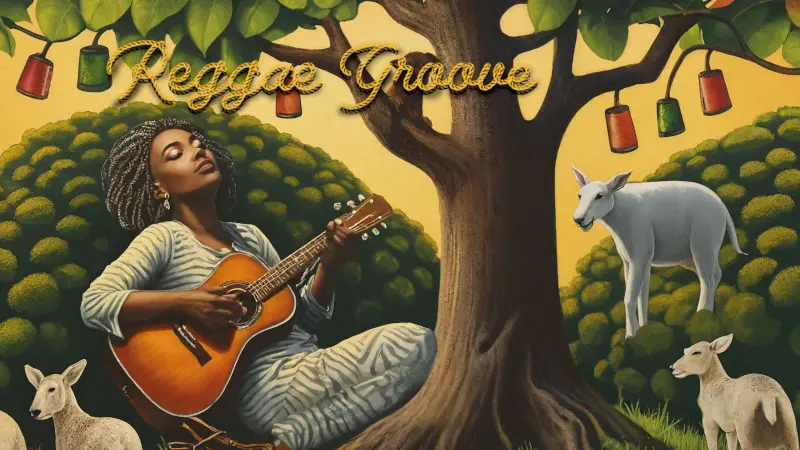
Lovers Rock: The Romantic Sound of Reggae and Its Lasting Legacy
When people think of reggae, the mind often goes to Bob Marley, protest songs, or deep basslines carrying messages of survival. But within reggae’s vast landscape lies a softer corner—one where the music sways rather than marches, and where the lyrics whisper about matters of the heart more than politics.
This is Lovers Rock, a reggae subgenre that blossomed not in Kingston but in 1970s London. Its rhythms tell a story of tenderness, identity, and resilience all at once.
Often called romantic reggae music, Lovers Rock became the soundtrack for Black British youth navigating love in a society that wasn’t always welcoming.
It holds a special place in reggae history, one that is both musically enchanting and culturally vital. This piece drills into the beginnings, prominent artists, and enduring impact of this distinctive genre.

The Birth of Lovers Rock in 1970s Britain
Unlike roots reggae, which was steeped in Rastafarian spirituality and the struggles of post-colonial Jamaica, Lovers Rock found its footing in a very different landscape. Britain in the 1970s was a country wrestling with immigration, racism, and economic hardship. For the children of Caribbean migrants—often caught between Jamaican traditions at home and British society outside—music became a language of belonging.
Lovers Rock began as their voice. The rhythms were still unmistakably reggae: off-beat guitar strokes, steady basslines, and echoes of dub production. But the content shifted. Instead of Rastafari teachings or revolutionary calls, the lyrics leaned into romance, heartbreak, and intimacy. It was, in many ways, a quieter revolution—one that celebrated everyday emotion at a time when Black expression in Britain was often politicized or policed.
Many historians suggest that the origins of Lovers Rock came out of sound system culture. London DJs began spinning slower, soulful reggae cuts at dances, giving couples a chance to hold each other close. Soon, local singers and producers started tailoring songs to meet this demand, and a new subgenre was born organically out of the needs of the dancefloor.

The Musical DNA of Romantic Reggae
What makes Lovers Rock stand apart from other reggae subgenres isn’t just its lyrical themes but also its stylistic choices. The Lovers Rock sound carries a sweetness that reggae purists sometimes dismissed as too soft—but audiences embraced it. The melodies frequently integrated elements of soul and R&B, taking cues from American musicians while still keeping reggae’s essence.
Listen closely, and you’ll notice that reggae love songs in the Lovers Rock tradition often carry a different vocal character: falsettos, melismatic flourishes, and layered backing vocals that cushion the rhythm. Producers used more reverb, creating a dreamy quality.
The result was music that felt both grounded and ethereal, as if roots reggae had been dipped in honey.
Female Singers: The Queens of Lovers Rock
One of Lovers Rock’s defining contributions to reggae culture is its elevation of female singers. In Jamaica, reggae had certainly produced powerful women, from Marcia Griffiths to Judy Mowatt, but the UK scene placed women at the very center of its romantic turn.
- Carroll Thompson: Crowned the “Queen of Lovers Rock,” her 1981 album Hopelessly in Love is often cited as one of the greatest Lovers Rock albums ever recorded, blending vulnerability with quiet strength.
- Janet Kay: Her 1979 hit “Silly Games”—written and produced by Dennis Bovell—soared into the UK Top 40. Not only did her soaring falsetto get notice, but it also changed the perception of reggae among general listeners.
- Louisa Mark: Often acknowledged with influencing the early Lovers Rock sound, Louisa Mark wrote the song “Caught You in a Lie.”
- Sandra Cross: In the 1980s, Sandra Cross kept the fire going with singles like “Country Living.”
These singers weren’t side notes; they were the stars. Their success made Lovers Rock one of the first reggae subgenres where women’s voices carried as much weight—and sometimes more—than men’s.

Lovers Rock and the Dancefloor
If roots reggae was made for meditative listening, Lovers Rock was designed for dance. In London and other UK cities, sound systems became the heartbeat of community gatherings. These were more than just music venues; for Black Britons who frequently felt excluded from mainstream clubs, they served as a sense of community.
During these sessions, an extraordinary event occurred. Instead of aggressive pushing and shouting, you’d see couples leaning close, swaying to the gentle throb of bass and echoing guitars. Intimacy seemed safe in public settings because of Lovers Rock. For many second-generation Caribbean youth navigating the tightrope between strict home lives and hostile public streets, these dances were a kind of sanctuary.
One might argue that Lovers Rock wasn’t just a genre but a social ritual. The music was almost like an antidote to the toughness expected of young Black men and the guardedness often demanded of young Black women in Britain at the time. On the dancefloor, tenderness was allowed.
Critiques: Too Soft or Just What Was Needed?
Not everyone embraced Lovers Rock with open arms. Some reggae purists criticized it as being too sweet, too focused on romance when there were urgent political issues to address.
Against this backdrop, a genre centered on “I love you” and “don’t leave me” appeared trivial to some, however, the cultural context is overlooked in this analysis.
For young Black Britons growing up amid racism, police harassment, and job discrimination, expressing love and joy wasn’t escapism—it was survival. To sing about love in a hostile society was a form of resistance in itself. The softness was intentional, a counterweight to the hardness of their daily realities.
There’s also a quieter critique that Lovers Rock didn’t always challenge gender stereotypes. While it amplified women’s voices, some lyrics leaned into portrayals of women as dependent or heartbreak-driven. But at the same time, female singers were given unprecedented space in reggae, which shifted the balance of representation in the genre.
So, Lovers Rock may appear “soft” on the surface, but its softness was political in its own way.

Global Reach and the Legacy of Lovers Rock
Despite being born in the UK, Lovers Rock wasn’t only played on British soil. By the 1980s, its influence was spreading, thanks partly to Jamaican artists who began weaving romance more deliberately into their repertoire.
- Gregory Isaacs: Known as the “Cool Ruler,” he built much of his career on smooth, romantic reggae tracks that resonated with Lovers Rock audiences.
- Maxi Priest: He emerged as a crossover star, taking the Lovers Rock sensibility into reggae fusion territory and eventually into international charts with hits like “Close to You.”
Even in the United States, Lovers Rock found an audience among those drawn to its blend of soul, reggae, and pop accessibility. By the late ’80s and early ’90s, the genre had become a bridge—connecting the Caribbean diaspora to broader popular music trends.
Cultural identity also weighed heavily on Lovers Rock. It was the sound of adolescence for many Black Britons in the 1970s and ’80s who didn’t feel fully Jamaican or fully British. They found a hybrid identity expressed in the music.
According to some academics, Lovers Rock was actually the first genuine Black British genre, paving the way for grime, UK garage, and jungle.
What Is the Difference Between Lovers Rock and Roots Reggae?
The significance of Lovers Rock’s cultural identity extended beyond its music. For many Black Britons in the 1970s and ’80s, it was the sound of adolescence. Young people who didn’t always feel fully Jamaican or fully British found a hybrid identity expressed in the music. They owned Lovers Rock; it wasn’t just something they took from Britain or imported straight from Jamaica.
According to some academics, Lovers Rock was actually the first genuine Black British genr. It predated the explosion of grime, UK garage, or jungle, and in many ways paved the way for them. By proving that second-generation Caribbean youth could create something uniquely their own, Lovers Rock set the blueprint for British Black musical innovation.
At the same time, it functioned as a healing force. Songs about heartbreak may sound universal, but when sung in reggae’s cadence by young Caribbean voices in London, they became a mirror for a community learning to balance multiple identities.

Landmark Songs and Albums
Certain records became pillars of the Lovers Rock canon. A few standouts include:
- Janet Kay’s 1979 hit “Silly Games” (see video above) utilized a falsetto to elevate Lovers Rock within the UK music scene.
- Carroll Thompson – Recognized as the “Queen of Lovers Rock,” released her 1981 album Hopelessly in Love, which is frequently regarded as one of the finest Lovers Rock albums ever made, combining sensitivity with quiet resilience.
- Louisa Mark (see video above) – Some believe that the entire movement was initiated by Louisa Mark’s track “Caught You in a Lie,” which emerged in the mid-1970s.
- Sandra Cross – Her1985 hit song “Country Living” demonstrated the genre’s enduring appeal until the middle of the 1980s.
- Maxi Priest – Close to You (1990): Showed the international potential of a Lovers Rock-inflected sound.
These songs didn’t just sell records; they created cultural touchpoints for entire generations.
Lovers Rock on Film and Memory
In 2011, director Menelik Shabazz released The Story of Lovers Rock, a documentary that captured the genre’s history through interviews, performances, and archival footage. The film reminded audiences just how much this music had meant — and how easily its importance could have been overlooked in reggae’s broader narrative.
Later, in his Small Axe anthology (2020), filmmaker Steve McQueen featured an episode that focused on Lovers Rock. The episode doesn’t just show people dancing; it recreates the almost spiritual atmosphere of a 1970s Lovers Rock house party. Watching it, one gets the sense that this wasn’t just music, but a lived experience, deeply tied to memory, migration, and survival.

Roots Reggae vs Lovers Rock: A Comparison
Feature | Roots Reggae | Lovers Rock |
Origin | Jamaica, 1970s | UK (London), mid-1970s |
Themes | Spirituality, resistance, politics | Romance, intimacy, heartbreak |
Main Voices | Mostly male singers | Strong presence of female singers |
Tone | Heavy, serious, meditative | Sweet, tender, soulful |
Audience Function | Call for social change | Soundtrack for love & community life |
This table simplifies the picture, but it highlights how Lovers Rock was never meant to replace roots reggae — it complemented it, offering balance.
What truly matters is not whether a song fits into a specific subgenre, but whether it captures that unique reggae blend of rhythm, vulnerability, and devotion.
The Legacy and Revival
By the 1990s, Lovers Rock had lost some of its mainstream momentum. Dancehall and ragga dominated both Jamaican and UK reggae scenes, and the romantic subgenre seemed, for a time, overshadowed. Yet it never fully disappeared.
In fact, Lovers Rock has seen a quiet revival in recent years. DJs still play the classics at nostalgic events, and younger musicians—particularly those from outside the Caribbean diaspora—have begun to rediscover its spirit.
The way that soul, reggae, and intimacy are blended in this genre appears to be ageless. Its legacy also lives on in unexpected ways.
The emphasis on romantic reggae songs influenced artists across R&B, soul, and reggae fusion. The tenderness of Lovers Rock may be heard in even contemporary pop-reggae songs.
More importantly, the genre had a cultural impact by proving that Black Britons could produce a sound that was both local and global, British and Caribbean, and sensitive and political.
Conclusion
Lovers Rock is more than just reggae’s romantic cousin. It’s about identity, survival, and joy.
To dismiss it as “soft reggae” is to ignore the deeper context: for a generation facing hostility in Britain, this music offered a soundtrack for both intimacy and resilience. Its cultural relevance and impact on world music are still relevant today.

